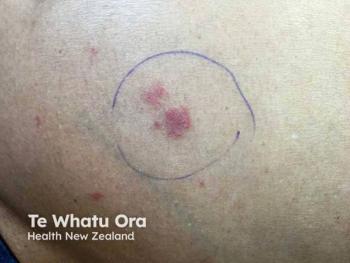
Prenatal Exposure to Inorganic Arsenic, Cadmium Associated with Atopic Dermatitis Risk
Investigators suggested the prevention of exposure during pregnancy could help control atopic dermatitis and other potential allergies in pediatric populations.
A new cohort study from Taiwan found that prenatal exposure to inorganic arsenic and co-exposure to inorganic arsenic and cadmium were associated with a higher risk of
Investigators led by Shu-Li Wang, PhD, National Institute of Environmental Health Sciences, Taiwan, believed these findings suggested that prevention of exposure to arsenic and cadmium during pregnancy could aid in the control of atopic dermatitis and other potential allergies in pediatric populations.
Though the association between prenatal exposure to arsenic and other metals and the risk of atopic dermatitis among young children was unknown, previous studies have noted that inorganic exposure was associated with allergic airway inflammation in children 8-14 years old.
As such, investigators aimed to investigate the association between prenatal exposure to multiple metals and the risk of atopic disease in pediatric populations.
The Methods
In total, 1152 pregnant women were enrolled in the Taiwan Maternal and Infant Cohort Study (TMICS), which Wang and colleagues culled data from.
The multicenter birth cohort study was conducted at 9 hospitals across Taiwan from October 2012 to May 2015.
Soon after, 586 mothers and children aged 4 years participated in follow-up questionnaires that were issued from August 2016 to January 2019
After some exclusions, a total of 370 mother and child pairs from the central and eastern region of Taiwan were included in the present study.
Data was collected through structured questionnaires that addressed demographic characteristics, lifestyle, dietary patterns, and residential environment. Physical measurements and urine samples were also obtained.
Assessment of metals and an estimation of total inorganic arsenic were quantified using an inductively coupled plasma mass spectrometer and linear regression analysis data from a previous TMICS study, respectively.
Maternal urinary metal Maternal urinary metal concentrations were log2-transformed for normality, and logistic regression analyses were used to estimate the association between prenatal exposure to 8 metals including arsenic, cadmium, lead, cobalt, copper, nickel, thallium, and zinc, as well as the risk of atopic dermatitis in children.
The Findings
According to the fully adjusted model featured in the study, every doubled increase in maternal urinary estimated total inorganic arsenic was significantly associated with 2.42-fold (95% CI, 1.33-4.39; P = .003) higher odds of atopic dermatitis in children at 4 years old.
All other maternal urinary metal concentrations were not associated with higher odds of atopic disease.
Wang and colleagues also recorded a significant association between maternal urinary arsenic concentrations and estimated total inorganic arsenic concentrations and atopic dermatitis according to the directed acyclic graph (arsenic: OR, 1.41 [95% CI, 1.15-1.74; P = .001]; estimated total inorganic arsenic: OR, 2.14 [95% CI, 1.23-3.73; P = .01]) and propensity scores (arsenic: OR, 1.49 [95% CI, 1.20-1.85; P < .001]; estimated total inorganic arsenic: OR, 2.36 [95% CI, 1.33-4.19; P = .003])
Additionally, every increased unit in the weighted quantile sum index of maternal metal exposure was significantly associated with atopic dermatitis (OR, 1.63; 95% CI, 1.28-2.07), with arsenic (40.1%) and cadmium (20.5%) accounting for most of the metal mixture index.
Of the prevention methods posed in the study, investigators noted that environmental exposure played a large role.
“Environmental improvements and reductions in contact with sources of exposure are important to reduce the risk of metal exposure among this susceptible population,” the team wrote.
The study,
This article was initially published by our sister publication
Newsletter
Like what you’re reading? Subscribe to Dermatology Times for weekly updates on therapies, innovations, and real-world practice tips.


















